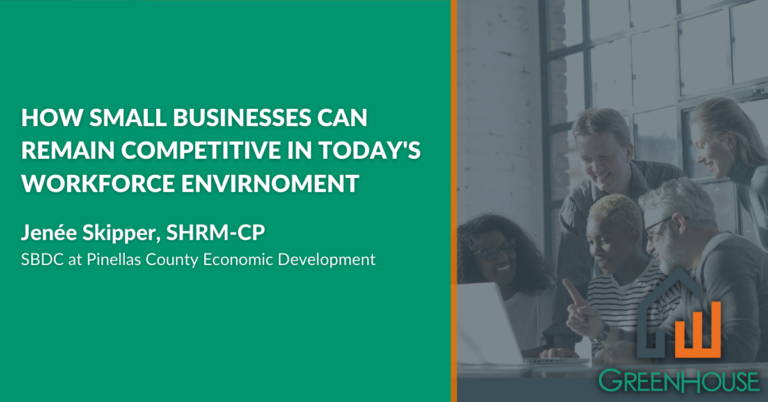Strategic Tips for small business to recruit and retain the best talent
By: Jenée Skipper, SHRM-CP

While recruiting the best talent has been a priority for most organizations; one often overlooked task has been retention efforts, at least until now. Since 2021, workforce shortages are of growing concern for most organizations and a recent report by Paige McAllister of Affinity HR Group revealed that, “recruitment and retention has been a top priority since the “Great Resignation.” More than three percent of the United States workforce voluntarily left their jobs.”
While many variables may account for workforce shortages, the COVID-19 pandemic has certainly exasperated the issue.
But wait, you don’t have to fret. There are many things an organization can do to remain competitive in today’s business climate. Get ahead of the issues by ensuring the following things are in place:
- A competitive compensation model
- A robust training program that will allow the upskilling of your current workforce
- Get back to the basics with "old-fashioned" communication to reestablish people skills
We are keenly aware that compensation is an important part of the hiring and retention process and getting it right on the front end offers extreme benefits.
Organizational benefits can be found through a decreased attrition rate, a decrease in mass exits for those seeking higher pay, and a decrease in your organizations’ overall recruiting cost.
To attract the right candidates, having a competitive compensation plan to include benefits, bonuses and/or commission will not only drive increased performance, but overall value. Valued employees often display higher morale and a greater sense of loyalty and in most instances, add to your bottom-line in terms of profitability and a continuum of services.
Professional Development Opportunities
To remain competitive in an increasingly tight labor market, employers must have more than a great onboarding process. Committing to the learning and development of your staff is one simple solution.
Studies have shown that employees who get regular opportunities to learn, develop, and advance are more likely to stay with a company. In fact, Bob Nelson, author of 1,001 Ways to Engage Employees, reports that learning and development are among the top factors in employee engagement.
Taking it one step further; meaningful training that leads to upward mobility and the upskilling of employees not only benefits the individual, but it will also demonstrate an organizations’ commitment to employee development by strengthening both personal growth and professional growth.
Training is a specific event that teaches new information or skills and is most often provided to new and/or promoted employees.
However, ongoing employee development is the continuous effort to strengthen the overall work performance. There are many ways to accomplish this with little financial burden to an organization. Peer-to peer-mentoring, coaching, cross training, web-based training sessions, and train the trainer workshops are just a few training exercises to internally strengthen your workforce.
Freedom of Flexibility
While the need to explore creative work arrangements have grown excessively, organizations can add tremendous value to retention efforts by establishing modified work schedules, male maternity leave and non-traditional shifts, to name a few, which may support a more balanced work and family life.
Fostering an environment for all.
Another key to learning is understanding what’s important to your employees by expanding your organizations diversity, equity and inclusion (DEI) efforts. The greatest return on your investment (ROI) is the investment into your staff. Not only does it build morale, it will also build loyalty and the confidence that you are as equally concerned about their personal growth and development as you are your bottom line. While you are enhancing your retention efforts, be sure to retain your intellectual property, which is knowledge. Ask yourself, how much knowledge is lost when we lose an employee
Continued Engagement
Employee engagement is one of the most effective tools in organizational improvement. Mitigating retention efforts by engaging your staff can be key to a successful process. Getting back to the basics with “old-fashioned” communication that will help your organization establish or reestablish people skills is paramount. Gathering valuable input is not only cost effective, but also transformative thinking.
Two examples which come to mind are employee surveys which lead to actionable outcomes and exit interviews that spark change. While artificial intelligence (AI) and automation has replaced many job functions, they can never replace the internal customer service experience that an employee’s engagement and team building experience can provide. Just as mentoring and being coachable are not assessable through processes but more so by human interaction and feedback.
Employees are talking. The question becomes are organizations listening? If you want to know what employees are thinking, ask. The answers may provide dividends for years to come.
ABOUT THE AUTHOR

Jenée Skipper, SHRM-CP
Pinellas County Economic Development
Jenée Skipper is a Business Assistance Specialist with the Florida Small Business Development Center at Pinellas County. Jenée joined the Pinellas team after serving as a valued business consultant. In this role she focused on client outreach, business recruitment, technical and financial services, and workforce assistance. She continues to build on these strengths as she assists pre-venture and start-up clients as they explore launching new businesses.
Jenée has a background in human resources and is a skilled job developer, recruiter and human resources representative with a professional focus on staff training and development, as well as project management and business processes. She uses these talents as she assists FSBDC clients with their workforce, recruitment and organizational needs.
